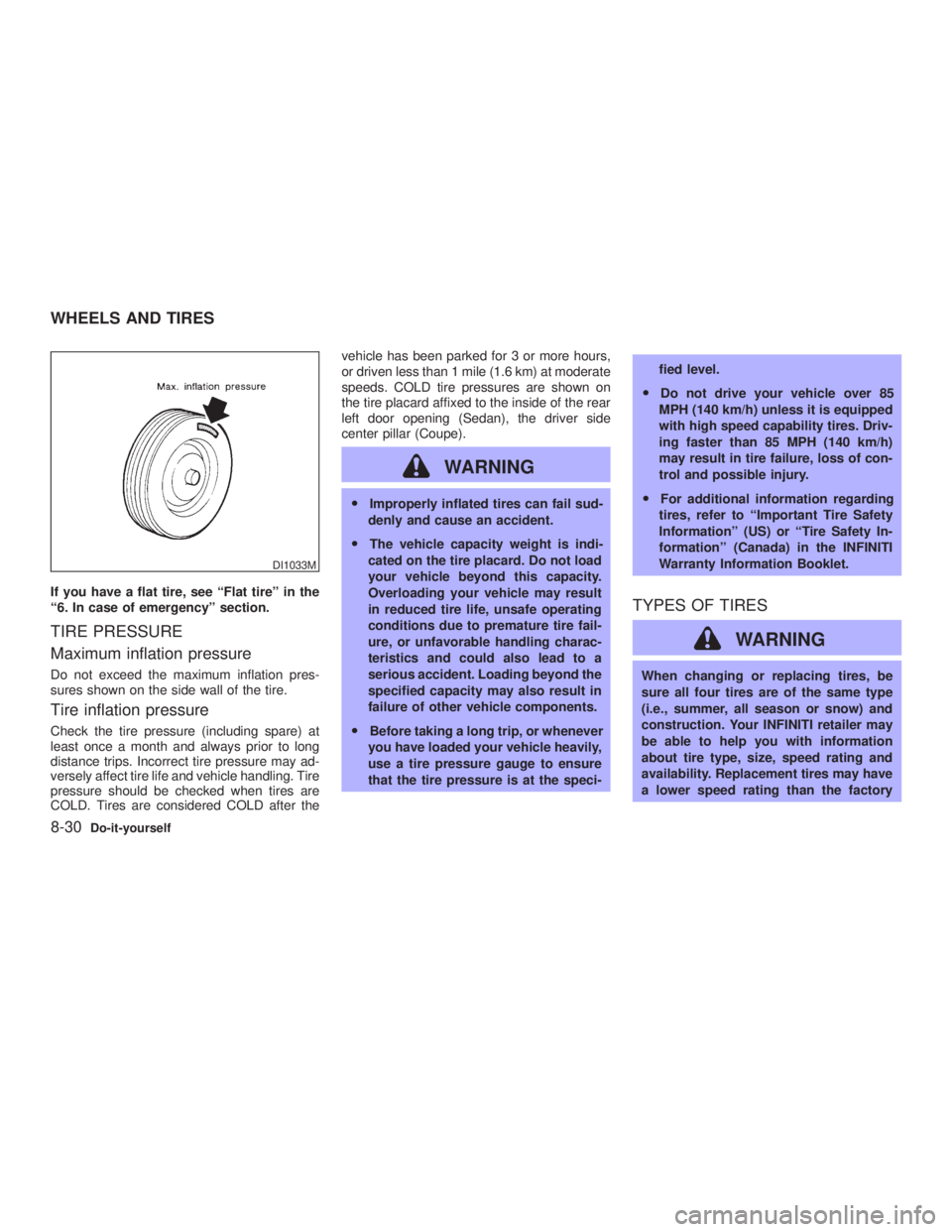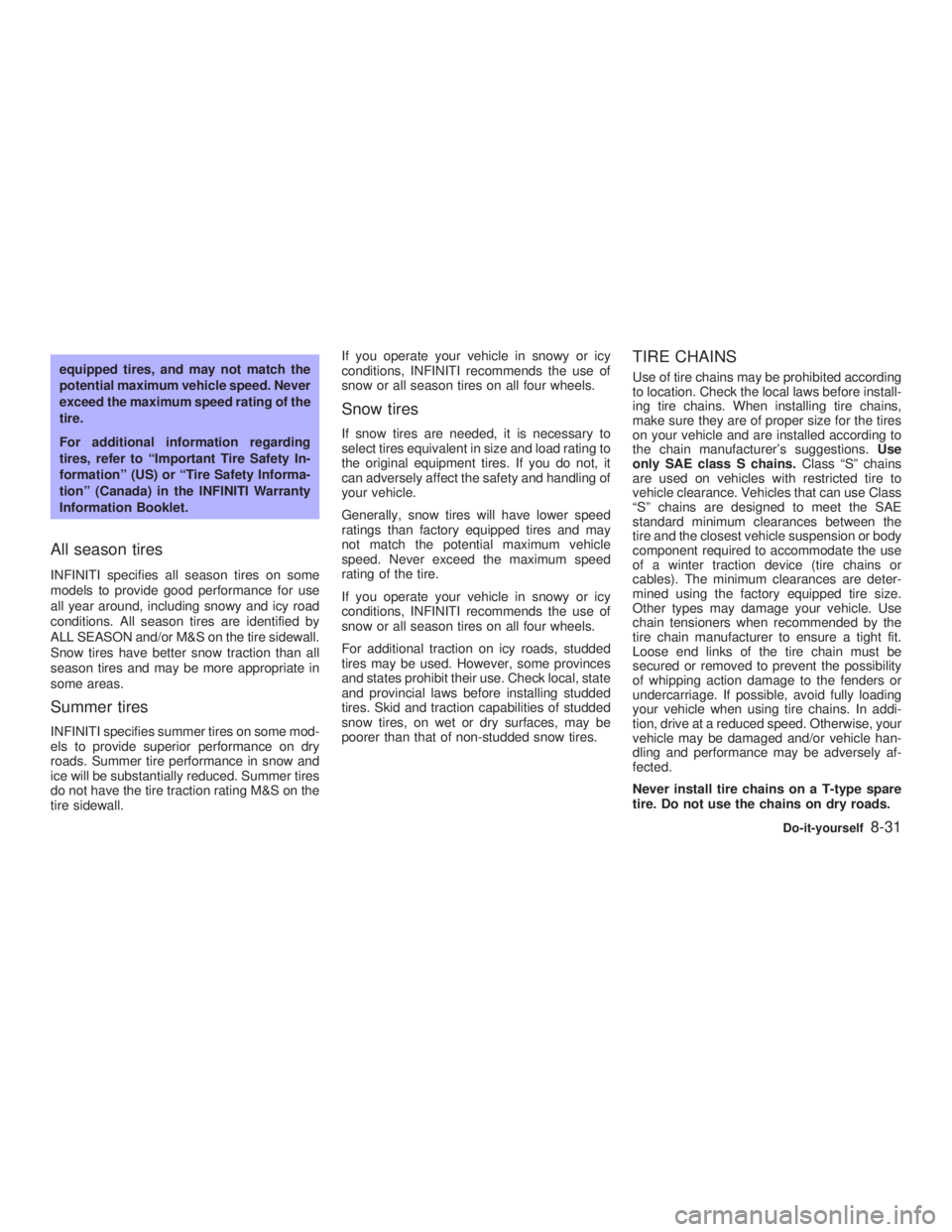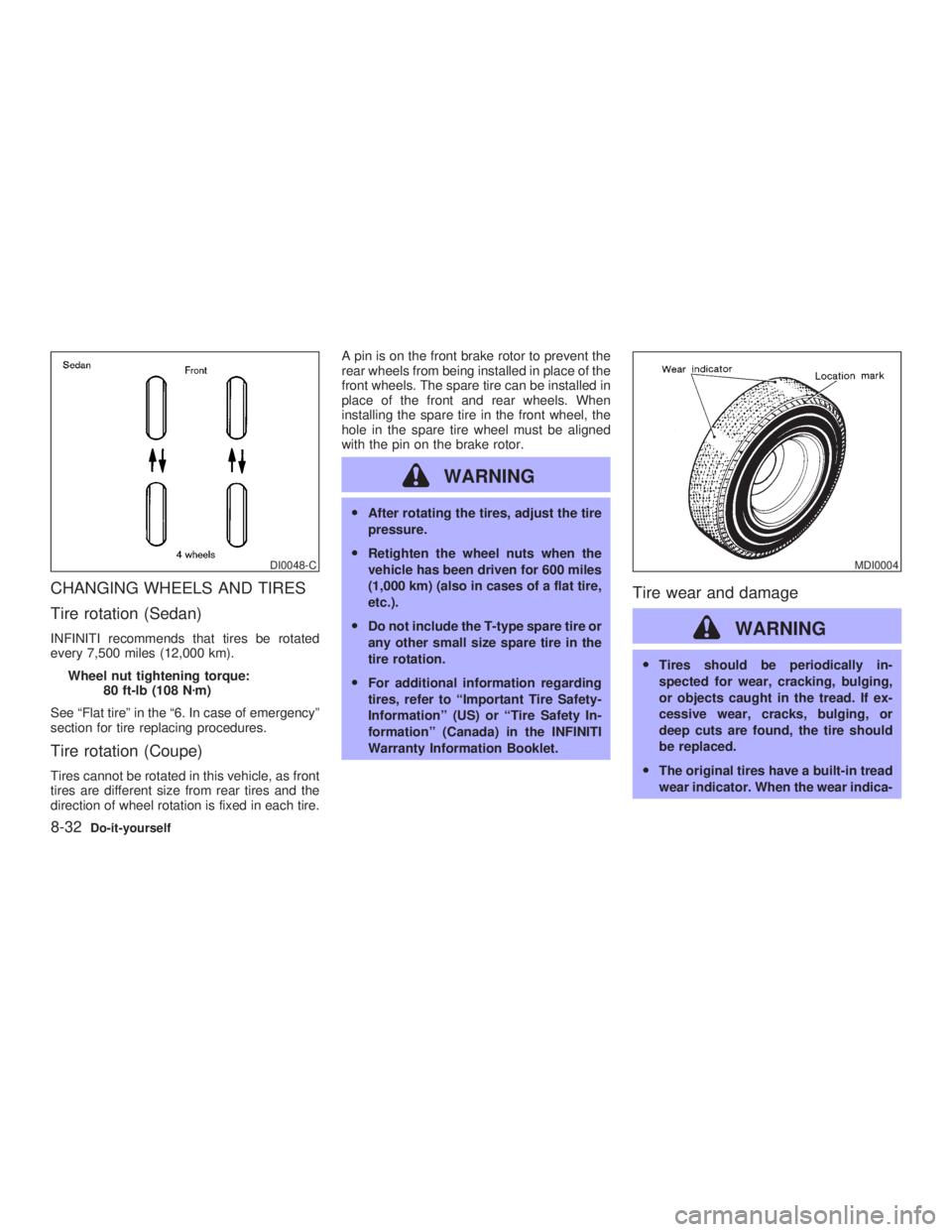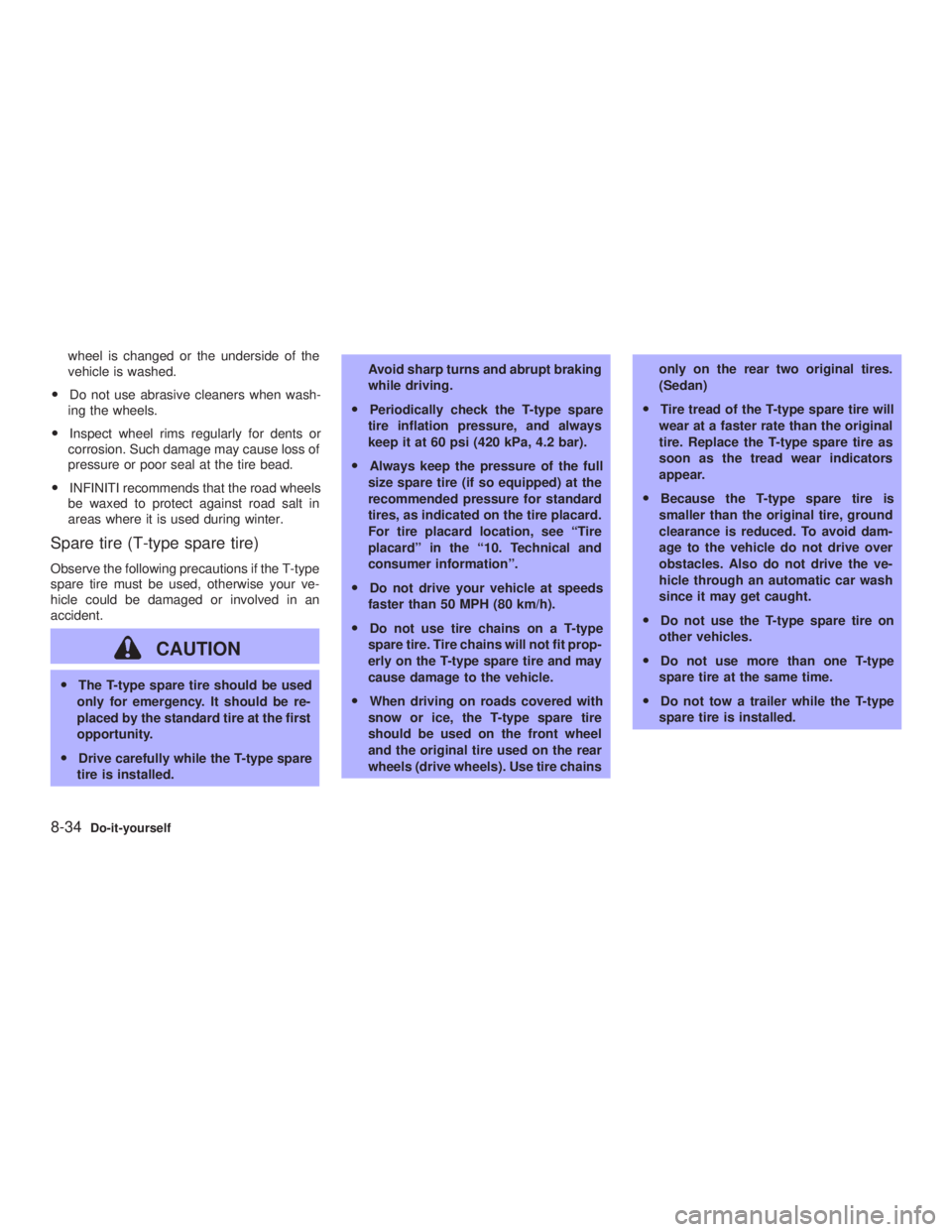2003 INFINITI G35 wheel size
[x] Cancel search: wheel sizePage 155 of 256

cidents resulting from careless or dan-
gerous driving techniques. It can help
maintain vehicle control during braking
on slippery surfaces, but remember that
the stopping distance on slippery sur-
faces will be longer than on normal
surfaces, even with the anti-lock sys-
tem. Stopping distances may also be
longer on rough, gravel or snow covered
roads, or if you are using tire chains.
Always maintain a safe distance from
the vehicle in front of you. Ultimately,
the responsibility for safety of yourself
and others rests in the hands of the
driver.
Tire type and condition of tires may also
affect braking effectiveness.
O When replacing tires, install the
specified size of tires on all four
wheels.
O When installing a spare tire, make
sure it is the proper size and type as
specified on the tire placard. See ªVe-
hicle identificationº in the ª10. Tech-
nical and consumer informationº sec- tion for tire placard location. When driving on slippery surfaces or suddenly
avoiding obstacles on roads, the vehicle might
swerve or slip. With the vehicle dynamics
control (VDC) system, sensors detect these
movements and control the braking and en-
gine output to help improve vehicle stability
while driving.
O When the vehicle dynamics control system
is operating, the slip indicator in the instru-
ment panel blinks.
O When only the traction control system por-
tion of the vehicle dynamics control system
is operating, the slip indicator will also blink.
O If the slip indicator blinks, the vehicle is
under slippery conditions. Be sure to drive
carefully. See ªSlip indicator lightº, and ªVe-
hicle dynamics control off indicator lightº in
the ª2. Instruments and controlsº section.
O Indicator light
If a malfunction occurs in the system, the
SLIP and indicator lights come on in
the meter panel.
As long as these warning lights are on, the
traction control function is canceled.
The VDC system uses a Brake Limited Slip
Differential (LSD) system to improve vehicle
traction. The brake LSD system works when
one of the driving wheels is spinning on aVEHICLE DYNAMICS CONTROL
(VDC) SYSTEM
Starting and driving
5-21
Z 02.7.29/V35-D/V5.0
X
Page 157 of 256

FREEING A FROZEN DOOR LOCK To prevent a door lock from freezing, apply
de-icer or glycerin to it through the key hole. If
the lock becomes frozen, heat the key before
inserting it into the key hole.
ANTI-FREEZE In the winter when it is anticipated that the
temperature will drop below 32ÉF (0ÉC), check
anti-freeze to assure proper winter protection.
For additional information, see ªEngine Cool-
ing Systemº in the ª8. Do-it-yourselfº section.
BATTERY If the battery is not fully charged during ex-
tremely cold weather conditions, the battery
fluid may freeze and damage the battery. To
maintain maximum efficiency, the battery
should be checked regularly. For additional
information, see ªBatteryº in the ª8. Do-it-
yourselfº section.
DRAINING OF COOLANT WATER If the vehicle is to be left outside without
anti-freeze, drain the cooling system by open-
ing the drain plug located under the radiator.
Refill before operating the vehicle. See ªEn-
gine cooling systemº in the ª8. Do-it-yourselfº
section for changing engine coolant. TIRE EQUIPMENT 1. SUMMER tires are of a tread design to
provide superior performance on dry pave-
ment. However, the performance of these
tires will be substantially reduced in snowy
and icy conditions. If you operate your
vehicle on snowy or icy roads, INFINITI
recommends the use of MUD & SNOW or
ALL SEASON tires on all four wheels.
Please consult your INFINITI retailer for the
tire type, size, speed rating and availability
information.
2. For additional traction on icy roads, studded
tires may be used. However, some prov-
inces and states prohibit their use. Check
local, state and provincial laws before in-
stalling studded tires.
Skid and traction capabilities of studded
snow tires, on wet or dry surfaces, may be
poorer than that of non-studded snow tires.
3. Tire chains may be used if desired. Make
sure they are of proper size for the tires on
your vehicle and are installed according to
the chain manufacturer's suggestions. Use
of tire chains may be prohibited according
to location. Check the local laws before
installing tire chains. When installing tire
chains, make sure they are of proper size
for the tires on your vehicle and are in- stalled according to the chain manufactur-
er's suggestions. Use only SAE Class S
chains. Class ªSº chains are used on ve-
hicles with restricted tire to vehicle clear-
ance. Vehicles that can use Class ªSº
chains are designed to meet the SAE stan-
dard minimum clearances between the tire
and the closest vehicle suspension or body
component required to accommodate the
use of a winter traction device (tire chains
or cables). The minimum clearances are
determined using the factory equipped tire
size. Other types may damage your ve-
hicle. Use chain tensioners when recom-
mended by the tire chain manufacturer to
ensure a tight fit. Loose end links of the tire
chain must be secured or removed to pre-
vent the possibility of whipping action dam-
age to the fenders or underbody. If pos-
sible, avoid fully loading your vehicle when
using tire chains. In addition, drive at a
reduced speed. Otherwise, your vehicle
may be damaged and/or vehicle handling
and performance may be adversely af-
fected.
Never install tire chains on a T-type spare
tire. Do not use tire chains on dry roads.
SPECIAL WINTER EQUIPMENT It is recommended that the following items beCOLD WEATHER DRIVING
Starting and driving
5-23
Z 02.7.29/V35-D/V5.0
X
Page 165 of 256

Stowing the damaged tire and tools Securely store the spare tire and jacking
equipment in the vehicle.
WARNINGO Always make sure that the spare tire
and jacking equipment are properly
secured after use. Such items can
become dangerous projectiles in an
accident or sudden stop.
O The T-type spare tire and small size spare tire are designed for emer-
gency use. See ªWheels and tiresº in
the ª8. Do-it-yourselfº section.
If needed Roadside Assistance is available.
Please see your Warranty Information Booklet
or Roadside Assistance I.D. Card for the toll-
free number to call (U.S.) or Warranty & Road-
side assistance information booklet (Canada). To start your engine with a booster battery, the
instructions and precautions below must be
followed.
WARNING O If done incorrectly, jump starting can
lead to a battery explosion, resulting
in severe injury or death. It could also
damage your vehicle.
O Explosive hydrogen gas is always
present in the vicinity of the battery.
Keep all sparks and flames away from
the battery.
O Do not allow battery fluid to come
into contact with eyes, skin, cloth or
painted surfaces. Battery fluid is a
corrosive sulphuric acid solution
which can cause severe burns. If the
fluid should come into contact with
anything, immediately flush the con-
tacted area with water.
O Keep battery out of the reach of
children.SCE0384A SCE0425
JUMP STARTING
In case of emergency
6-7
Z 02.7.29/V35-D/V5.0
X
Page 208 of 256

If you have a flat tire, see ªFlat tireº in the
ª6. In case of emergencyº section.
TIRE PRESSURE
Maximum inflation pressure Do not exceed the maximum inflation pres-
sures shown on the side wall of the tire.
Tire inflation pressure Check the tire pressure (including spare) at
least once a month and always prior to long
distance trips. Incorrect tire pressure may ad-
versely affect tire life and vehicle handling. Tire
pressure should be checked when tires are
COLD. Tires are considered COLD after the vehicle has been parked for 3 or more hours,
or driven less than 1 mile (1.6 km) at moderate
speeds. COLD tire pressures are shown on
the tire placard affixed to the inside of the rear
left door opening (Sedan), the driver side
center pillar (Coupe).
WARNING O Improperly inflated tires can fail sud-
denly and cause an accident.
O The vehicle capacity weight is indi-
cated on the tire placard. Do not load
your vehicle beyond this capacity.
Overloading your vehicle may result
in reduced tire life, unsafe operating
conditions due to premature tire fail-
ure, or unfavorable handling charac-
teristics and could also lead to a
serious accident. Loading beyond the
specified capacity may also result in
failure of other vehicle components.
O Before taking a long trip, or whenever
you have loaded your vehicle heavily,
use a tire pressure gauge to ensure
that the tire pressure is at the speci- fied level.
O Do not drive your vehicle over 85
MPH (140 km/h) unless it is equipped
with high speed capability tires. Driv-
ing faster than 85 MPH (140 km/h)
may result in tire failure, loss of con-
trol and possible injury.
O For additional information regarding
tires, refer to ªImportant Tire Safety
Informationº (US) or ªTire Safety In-
formationº (Canada) in the INFINITI
Warranty Information Booklet.
TYPES OF TIRES
WARNING When changing or replacing tires, be
sure all four tires are of the same type
(i.e., summer, all season or snow) and
construction. Your INFINITI retailer may
be able to help you with information
about tire type, size, speed rating and
availability. Replacement tires may have
a lower speed rating than the factoryDI1033M
WHEELS AND TIRES
8-30 Do-it-yourself
Z 02.7.29/V35-D/V5.0
X
Page 209 of 256

equipped tires, and may not match the
potential maximum vehicle speed. Never
exceed the maximum speed rating of the
tire.
For additional information regarding
tires, refer to ªImportant Tire Safety In-
formationº (US) or ªTire Safety Informa-
tionº (Canada) in the INFINITI Warranty
Information Booklet.
All season tires INFINITI specifies all season tires on some
models to provide good performance for use
all year around, including snowy and icy road
conditions. All season tires are identified by
ALL SEASON and/or M&S on the tire sidewall.
Snow tires have better snow traction than all
season tires and may be more appropriate in
some areas.
Summer tires INFINITI specifies summer tires on some mod-
els to provide superior performance on dry
roads. Summer tire performance in snow and
ice will be substantially reduced. Summer tires
do not have the tire traction rating M&S on the
tire sidewall. If you operate your vehicle in snowy or icy
conditions, INFINITI recommends the use of
snow or all season tires on all four wheels.
Snow tires If snow tires are needed, it is necessary to
select tires equivalent in size and load rating to
the original equipment tires. If you do not, it
can adversely affect the safety and handling of
your vehicle.
Generally, snow tires will have lower speed
ratings than factory equipped tires and may
not match the potential maximum vehicle
speed. Never exceed the maximum speed
rating of the tire.
If you operate your vehicle in snowy or icy
conditions, INFINITI recommends the use of
snow or all season tires on all four wheels.
For additional traction on icy roads, studded
tires may be used. However, some provinces
and states prohibit their use. Check local, state
and provincial laws before installing studded
tires. Skid and traction capabilities of studded
snow tires, on wet or dry surfaces, may be
poorer than that of non-studded snow tires. TIRE CHAINS Use of tire chains may be prohibited according
to location. Check the local laws before install-
ing tire chains. When installing tire chains,
make sure they are of proper size for the tires
on your vehicle and are installed according to
the chain manufacturer's suggestions. Use
only SAE class S chains. Class ªSº chains
are used on vehicles with restricted tire to
vehicle clearance. Vehicles that can use Class
ªSº chains are designed to meet the SAE
standard minimum clearances between the
tire and the closest vehicle suspension or body
component required to accommodate the use
of a winter traction device (tire chains or
cables). The minimum clearances are deter-
mined using the factory equipped tire size.
Other types may damage your vehicle. Use
chain tensioners when recommended by the
tire chain manufacturer to ensure a tight fit.
Loose end links of the tire chain must be
secured or removed to prevent the possibility
of whipping action damage to the fenders or
undercarriage. If possible, avoid fully loading
your vehicle when using tire chains. In addi-
tion, drive at a reduced speed. Otherwise, your
vehicle may be damaged and/or vehicle han-
dling and performance may be adversely af-
fected.
Never install tire chains on a T-type spare
tire. Do not use the chains on dry roads. Do-it-yourself
8-31
Z 02.7.29/V35-D/V5.0
X
Page 210 of 256

CHANGING WHEELS AND TIRES
Tire rotation (Sedan) INFINITI recommends that tires be rotated
every 7,500 miles (12,000 km).
Wheel nut tightening torque:
80 ft-lb (108 N z m)
See ªFlat tireº in the ª6. In case of emergencyº
section for tire replacing procedures.
Tire rotation (Coupe) Tires cannot be rotated in this vehicle, as front
tires are different size from rear tires and the
direction of wheel rotation is fixed in each tire. A pin is on the front brake rotor to prevent the
rear wheels from being installed in place of the
front wheels. The spare tire can be installed in
place of the front and rear wheels. When
installing the spare tire in the front wheel, the
hole in the spare tire wheel must be aligned
with the pin on the brake rotor.
WARNING O After rotating the tires, adjust the tire
pressure.
O Retighten the wheel nuts when the
vehicle has been driven for 600 miles
(1,000 km) (also in cases of a flat tire,
etc.).
O Do not include the T-type spare tire or
any other small size spare tire in the
tire rotation.
O For additional information regarding
tires, refer to ªImportant Tire Safety-
Informationº (US) or ªTire Safety In-
formationº (Canada) in the INFINITI
Warranty Information Booklet. Tire wear and damage
WARNING O Tires should be periodically in-
spected for wear, cracking, bulging,
or objects caught in the tread. If ex-
cessive wear, cracks, bulging, or
deep cuts are found, the tire should
be replaced.
O The original tires have a built-in tread
wear indicator. When the wear indica-DI0048-C MDI0004
8-32 Do-it-yourself
Z 02.11.1/V35-D/V5.0
X
Page 211 of 256

tor is visible, the tire should be re-
placed.
O Improper service for a spare tire may
result in serious personal injury. If it
is necessary to repair the spare tire,
contact your INFINITI retailer.
O For additional information regarding
tires, refer to ªImportant Tire Safety
Informationº (US) or ªTire Safety In-
formationº (Canada) in the INFINITI
Warranty Information Booklet.
Replacing wheels and tires When replacing a tire, use the same size,
speed rating and load carrying capacity as
originally equipped. See ªSpecificationsº in the
ª10. Technical and consumer informationº sec-
tion for recommended types and sizes of tires
and wheels.
WARNINGO The use of tires other than those
recommended or the mixed use of tires of different brands, construction
(bias, bias-belted or radial), or tread
patterns can adversely affect the ride,
braking, handling, ground clearance,
body-to-tire clearance, tire chain
clearance, speedometer calibration,
headlight aim and bumper height.
Some of these effects may lead to
accidents and could result in serious
personal injury.
O If the wheels are changed for any
reason, always replace with wheels
which have the same offset dimen-
sion. Wheels of a different offset
could cause early tire wear, possibly
degraded vehicle handling character-
istics and/or interference with the
brake discs. Such interference can
lead to decreased braking efficiency
and/or early brake pad wear.
O Do not install a deformed wheel or
tire even if it has been repaired. Such
wheels or tires could have structural
damage and could fail without
warning. O The use of retread tires is not recom-
mended.
O For additional information regarding
tires, refer to ªImportant Tire Safety
Informationº (US) or ªTire Safety In-
formationº (Canada) in the INFINITI
Warranty Information Booklet.
Wheel balance Unbalanced wheels may affect vehicle han-
dling and tire life. Even with regular use,
wheels can get out of balance. Therefore, they
should be balanced as required.
Wheel balance service should be performed
with the wheels off the vehicle. Spin balancing
the rear wheels on the vehicle could lead to
transmission damage.
For additional information regarding tires, refer
to ªImportant Tire Safety Informationº (US) or
ªTire Safety Informationº (Canada) in the
INFINITI Warranty Information Booklet.
Care of wheels O Wash the wheels when washing the vehicle
to maintain their appearance.
O Clean the inner side of the wheels when the Do-it-yourself
8-33
Z 02.7.29/V35-D/V5.0
X
Page 212 of 256

wheel is changed or the underside of the
vehicle is washed.
O Do not use abrasive cleaners when wash-
ing the wheels.
O Inspect wheel rims regularly for dents or
corrosion. Such damage may cause loss of
pressure or poor seal at the tire bead.
O INFINITI recommends that the road wheels
be waxed to protect against road salt in
areas where it is used during winter.
Spare tire (T-type spare tire) Observe the following precautions if the T-type
spare tire must be used, otherwise your ve-
hicle could be damaged or involved in an
accident.
CAUTIONO The T-type spare tire should be used
only for emergency. It should be re-
placed by the standard tire at the first
opportunity.
O Drive carefully while the T-type spare
tire is installed. Avoid sharp turns and abrupt braking
while driving.
O Periodically check the T-type spare
tire inflation pressure, and always
keep it at 60 psi (420 kPa, 4.2 bar).
O Always keep the pressure of the full
size spare tire (if so equipped) at the
recommended pressure for standard
tires, as indicated on the tire placard.
For tire placard location, see ªTire
placardº in the ª10. Technical and
consumer informationº.
O Do not drive your vehicle at speeds
faster than 50 MPH (80 km/h).
O Do not use tire chains on a T-type
spare tire. Tire chains will not fit prop-
erly on the T-type spare tire and may
cause damage to the vehicle.
O When driving on roads covered with
snow or ice, the T-type spare tire
should be used on the front wheel
and the original tire used on the rear
wheels (drive wheels). Use tire chains only on the rear two original tires.
(Sedan)
O Tire tread of the T-type spare tire will
wear at a faster rate than the original
tire. Replace the T-type spare tire as
soon as the tread wear indicators
appear.
O Because the T-type spare tire is
smaller than the original tire, ground
clearance is reduced. To avoid dam-
age to the vehicle do not drive over
obstacles. Also do not drive the ve-
hicle through an automatic car wash
since it may get caught.
O Do not use the T-type spare tire on
other vehicles.
O Do not use more than one T-type
spare tire at the same time.
O Do not tow a trailer while the T-type
spare tire is installed.
8-34 Do-it-yourself
Z 02.7.29/V35-D/V5.0
X